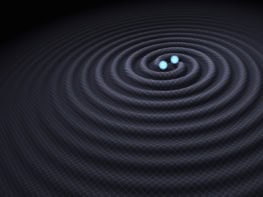
Physicists backing Japan to build the ¥600bn ($5bn) International Linear Collider (ILC) must re-evaluate their plans and “shelve” the question of the country hosting the proposed next-generation particle collider. That is the stark message to emerge from a panel of senior Japanese officials who have examined progress made towards realizing the ILC. They conclude that it is too early for Japan to proceed towards construction of the ILC and instead call for further research and international support towards the project.
First mooted well over a decade ago as the successor to the Large Hadron Collider at the CERN particle-physics lab near Geneva, the ILC – if built – would accelerate and smash together electrons with positrons to study the Higgs boson and other particles in precise detail. Collisions using these particles would be much “cleaner” than the proton–proton collisions that are carried out at the LHC.
The ILC’s five-volume technical design report was published in June 2013 and included a 30 km-long linear collider operating at around 500 GeV. The Japanese physics community expressed their desire to host the machine, with a site in the Tōhoku region, about 400 km north of Tokyo, chosen as a potential location.
But with little support for the go-ahead from the Japanese government, in 2017 physicists looked for cost savings and revised the plans to reduce the ILC’s energy to 250 GeV — an energy aimed to study the 125 GeV Higgs boson, which was discovered in 2012 at the LHC. This included shortening the length of the main tunnel to around 20 km, but leaving the option of later upgrading the collider to the original 500 GeV proposal and eventually to energies of around 1 TeV.
Yet in 2019 an independent committee of the Science Council of Japan (SCJ) failed to support the ILC’s construction in Japan, pointing out that the ILC did not yet have enough international backing. The Japanese government then laid out a condition that the ILC should be more widely supported by the Japanese and international scientific communities.
This would likely involve, for example, the ILC being included in the next roadmap of large science projects put together by Japan’s Ministry of Education, Culture, Sports, Science and Technology (MEXT), as well as pledges being made by other countries to support the project. Following that move officials at the KEK particle-physics lab then began negotiations on cost sharing arrangements for a “preparatory laboratory” for the ILC that would carry out the technical development and engineering design needed for the start of ILC construction.
In June 2021 ILC scientists published a 48-page plan for the ILC pre-lab and also submitted a report updating MEXT on progress since 2019. Those moves resulted in MEXT convening a committee in July 2021 that was tasked with evaluating the updated developments.
Our attention should now be more focussed on trying to find a host for a linear collider elsewhere in the world
Brian Foster
On 14 February the panel reported its findings, which were then released on 25 February. While recognizing the “academic significance of particle physics and the importance of the research activities, including that of a Higgs factory”, the panel says it is still “premature” to give the ILC pre-lab phase the go-ahead as they say this would be “coupled with an expression of interest to host the ILC by Japan”.
The panel adds that given the “increasing strain in the financial situation” of some countries that may provide support for the ILC, it recommends that those backing the collider should not only “reflect upon this fact and to re-evaluate the plan” but also “re-examine the approach towards a Higgs factory in a global manner”. This would involve considering progress made in other proposed collider projects such as the Future Circular Collider (FCC) – a 100 km-circumference collider that would be built by CERN. Disappointment as Japan fails to commit to hosting the International Linear Collider
The panel also calls for more work in key technologies towards a next-generation accelerator by “further strengthening international collaboration” among institutes and labs therefore “shelving the question of hosting the ILC”.
In response to the panel’s findings, KEK notes that it will now “re-examine the path for realizing the ILC as a Higgs factory” and consider the progress made in the FCC feasibility study. “KEK and the Japanese ILC community is committed to further advance important technological and engineering development in the accelerator area and to continue the effort for the realization of the ILC,” KEK noted in a statement.
Looking elsewhere
John Ellis from King’s College London says that the explicit reference to the FCC in the panel’s recommendations “sounds like a tacit judgement” that FCC studies have been making progress while the ILC has been stagnating. Ellis adds that the panel’s recommendations are in line with previous reviews that stated the ILC community had not done enough to line up broad scientific support within Japan or have substantial international commitments on board. “It sounds like they suggest the ILC is interesting, but advise to find another way of doing the physics by collaborating with the FCC,” adds Ellis.
Yet Hitoshi Murayama from the Kavli Institute for the Mathematics and Physics of the Universe in Tokyo told Physics World that while MEXT’s conclusion towards the pre-lab is “certainly unfortunate”, it is not all bad news. “KEK management is optimistic to acquire funds from MEXT to carry out key development work,” he says.
“The problem MEXT has is that they don’t want to fund the ILC pre-lab which may be interpreted as their tacit approval of the ILC as a whole by some proponents,” adds Murayama. “As long as the technology development does not carry the name ILC or specify the site in Japan, they may support the activity.” Europe unveils successor to the Large Hadron Collider
Some remain unconvinced. Particle physicist Brian Foster from the University of Oxford, who was European regional director for the ILC’s Global Design Effort, raises the prospect that the ILC may never be built in Japan. He says the MEXT review statement is “very disappointing” not only because it means delaying the ILC but also due to the way the decision was reached.
“It is apparent that some members of the committee did not approach their task with the openness of mind and belief in evidence-based conclusions that one would expect from senior members of the scientific community in an independent and unbiased review,” says Foster. “While we should continue to work with our Japanese colleagues to progress work on the ILC, our attention should now be more focused on trying to find a host for a linear collider elsewhere in the world.”
That view is backed by Phil Burrows, from the University of Oxford, who is the UK lead scientist in the ILC International Development Team. “Despite the best efforts of the particle physics community, not least via the International Committee for Future Accelerators, the Japanese government has yet to embrace the prospect of hosting ILC as a forefront global science facility,” he says. “Perhaps the time has indeed come to explore options elsewhere.” He points out that CERN, for example, has the “know-how and technical capability” to build a linear collider, although he admits that this “is not currently its stated top priority for a future project”.
International Linear Collider Q&A
What is the International Linear Collider (ILC)?
The ILC is a 20 km-long particle collider that will accelerate electrons and positrons to energies around 250 GeV. To do so, it will consist of thousands of superconducting radio-frequency accelerator cavities made of niobium. The ILC will then smash these beams together roughly 7000 times a second at an “interaction point”. The ILC will have two all-purpose detectors based around the interaction point — SiD and ILD — that would take turns being in the beam. Interchanging the detectors is estimated to take around a day to complete.
How is this different from CERN’s Large Hadron Collider?
The 27 km-circumference LHC is a circular collider made up of more conventional technology such as radio-frequency cavities that accelerate the beam, dipole magnets that bend the particles along a circular path, and quadrupole magnets that focus the beam. The ILC instead uses superconducting cavities to accelerate the beam along a straight path before being focused by quadrupole magnets. This linear acceleration has the advantage that the electrons do not lose energy via X-rays when travelling along a circular path. The benefit of a circular machine is that it allows for more integration points — four in the LHC’s case, with no need to swap detectors.
Has this accelerator technology been tested before?
Yes. The European X-ray Free Electron Laser (E-XFEL) facility near Hamburg, Germany, uses 768 superconducting niobium cavities to accelerate electrons to 17.5 GeV over 1.7 km. Rather than collide the particles, however, the E-XFEL makes them produce X-rays that are then used for a range of experiments from biophysics to condensed-matter physics. The E-XFEL is considered to some extent as an ILC prototype.
What would the ILC study?
Its main aim would be precision studies of the Higgs boson, which was discovered in 2012 at the LHC. The LHC has managed to measure the properties of the Higgs – notably how it couples to other particles – with a precision of around 20%. Yet the LHC’s proton–proton collisions suffer from a large amount of “debris” that affects the precision of the measurements. As electrons and positrons are fundamental particles, their collisions are much “cleaner” meaning that the ILC would improve this precision to 1% or lower. The ILC could also be later upgraded to higher energies to study the top quark.
Why is this exciting?
Physicists hope that the door to “new physics” could be opened through precision studies of particles such as the Higgs. This would come from deviations from those predicated by the Standard Model of particle physics.
Why has Japan dragged its feet for so long?
Japan has balked at the potential cost of building the ILC, which is one reason why physicists proposed a scaled-down version in 2017 that is both cheaper and would not take as long to build.
When could the ILC see the light of day?
Likely to be 2040s. If Japan gave it the go-ahead in the coming years then negotiations and preparations could take around four years to complete, with construction then taking a decade.
What other designs are on the table?
The CERN-led Compact Linear Collider would offer higher collision energies up to around 3 TeV, but the technology is not as mature as the ILC. Two other designs are circular colliders. China’s Circular Electron Positron Collider and the Future Circular Collider would both be 100 km-circumference colliders that would initially be used as a Higgs factory but could later be used for high-energy proton–proton collisions.



